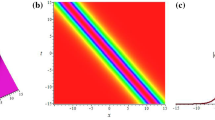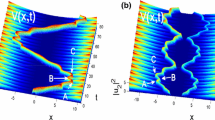Abstract
The central topic of interest in this conference revolves around the soliton mechanism first proposed by Davydov and Kislukha [1] as a means of transporting energy in molecular (mainly biological) aggregates. The last few years have seen a large amount of activity in this area, and this workshop has gathered many of the principals in the discussion. The study of the Fröhlich Hamiltonian [2] which is the starting point of the Davydov theory has become quite sophisticated and has overcome many of the restrictive assumptions that were necessarily introduced when the subject began. Thus, this conference has served to clarify many questions involving the effects of quantum fluctuations (since most theories are semiclassical), the meaning of localization when the tendency of a translationally invariant system is to delocalize wave functions, the effect of temperature on the stability of the Davydov soliton, and questions surrounding the soliton lifetime. On a more subtle level, much insight has been gained into the precise meaning of the approximations made at various historical stages of the subject, a case in point being the various variational principles that have been used to derive equations of motion for the Davydov system. The considerable theoretical advances do not yet unequivocally answer the question of the possible importance of soliton mechanisms in the transport of biological energy since the starting model in most theories (one-dimensional Fröhlich Hamiltonian) may be well removed from what goes on in real proteins. However, if the model is indeed appropriate, then the weight of the evidence suggests that at least in the α-helix soliton transport at room temperature (or even at low temperatures) should not play an important role (cf. Brown et al., this volume). Most of these issues and references to the work leading to our current understanding can be found throughout these proceedings.
Access this chapter
Tax calculation will be finalised at checkout
Purchases are for personal use only
Preview
Unable to display preview. Download preview PDF.
Similar content being viewed by others
References
A. S. Davydov and N. I. Kislukha, Phys. Status Solidi 59, 465 (1973); Zh. Eksp. Teor. Fiz. 71, 1090 (1976) [Sov. Phys.-JETP 44, 571 (1976)].
H. Fröhlich, H. Pelzer and S. Zieman, Philos. Mag. 41, 221 (1950); Proc. R. Soc. London Ser. A 215, 291 (1952); Adv. Phys. 3, 325 (1954).
S. Takeno, Prog. Theor. Phys. 71, 395 (1984).
S. Takeno, Prog. Theor. Phys. 73, 853 (1985).
S. Takeno, Prog. Theor. Phys. 75, 1 (1985).
X. Wang, D. W. Brown and K. Lindenberg, Phys. Rev. B 39, 5366 (1989).
A. Migliori, P. Maxton, A. M. Clogston, E. Zirngiebl and M. Lowe, Phys. Rev. B 38, 13464 (1988).
A. S. Davydov, Zh. Eksp. Teor. Fiz. 78, 789 (1980) [Sov. Phys.-JETP 51, 397 (1980)].
A. S. Davydov, Usp. Fiz. Nauk 138, 603 (1982) [Sov. Phys.-Usp. 25, 898 (1982)].
X. Wang, D. W. Brown, K. Lindenberg and B. J. West, Phys. Rev. A 37, 3557 (1988).
D. W. Brown, Phys. Rev. A 37, 5010 (1988).
K. Lindenberg, D. W. Brown and X. Wang, in Far from Equilibrium Phase Transitions, Lecture Notes in Physics Vol. 319, ed. L. Garrido (Springer, Berlin, 1988).
Z. Ivic and D. W. Brown, Phys. Rev. Letters 63, 426 (1989).
H. Bolterauer and R. D. Henkel, Phys. Scripta T13, 314 (1986).
M. J. Skrinjar, D. V. Kapor and S. D. Stojanovic, Phys. Rev. A 38, 6402 (1988).
Q. Zhang, V. Romero-Rochin and R. Silbey, Phys. Rev. A 38, 6409 (1988).
X. Wang, D. W. Brown and K. Lindenberg, Phys. Rev. Letters 62, 1706 (1989).
T. B. Benjamin and J. F. Feir, J. Fluid Mech. 27, 417 (1967).
A. C. Newell, Solitons in Mathematics and Physics (Society for Industrial and Applied Mathematics, Philadelphia, 1985).
G. B. Whithan, Linear and Nonlinear Waves (Wiley, New York, 1974).
Author information
Authors and Affiliations
Editor information
Editors and Affiliations
Rights and permissions
Copyright information
© 1990 Springer Science+Business Media New York
About this chapter
Cite this chapter
Lindenberg, K., Wang, X., Brown, D.W. (1990). Vibron Solitons: A Semiclassical Approach. In: Christiansen, P.L., Scott, A.C. (eds) Davydov’s Soliton Revisited. NATO ASI Series, vol 243. Springer, Boston, MA. https://doi.org/10.1007/978-1-4757-9948-4_4
Download citation
DOI: https://doi.org/10.1007/978-1-4757-9948-4_4
Publisher Name: Springer, Boston, MA
Print ISBN: 978-1-4757-9950-7
Online ISBN: 978-1-4757-9948-4
eBook Packages: Springer Book Archive




